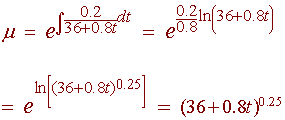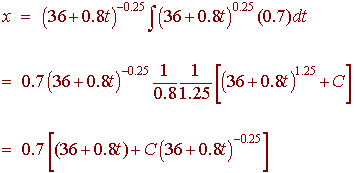Applications of Differential Equations
Anytime that we a relationship between how something changes, when it is changes, and how much there is of it, a differential equations will arise. Applications include population dynamics, business growth, physical motion of objects, spreading of rumors, carbon dating, and the spreading of a pollutant into an environment to name a few.
Population Growth
The current population of California is 36 million with a 33% Hispanic population. The rate of people entering the state, by being born or immigrating, is approximately 1 million people per year with 70% of the newcomers Hispanic. The rate of departure of the population, by dying or emigrating, is approximately 0.2 million people per year. Assume that the departing population has the same ethnic mix as California's population at the time of departure. In 20 years, what percent of California will be Hispanic?
Solution
We use a useful fact applicable to any question where there is input and output through a system:
Total Rate = Rate In - Rate Out
In this case, if we let x represent the number of Hispanics in the state and t represent the time in years from now, then we have
dx
Total Rate
=
dt
The rate in will be 70% of 1 million or
Rate In = 0.7(1) = 0.7
The rate out is more difficult. At time t, there are x Hispanics in California. To find the population of California, we take the initial population plus the added population per year times the number of years. Since there are 1 million people entering and 0.2 million leaving the population at time t is
P(t) = 36 + (1 - 0.2)t = 36 + 0.8t
Hence the rate of Hispanics leaving can be found by multiplying the proportion of Hispanics in the state and the rate of people leaving the state.
Number of Hispanics
Rate Out
=
* Rate of all leaving California
Number of Californians
x
Rate Out
=
* 0.2
36 + 0.8t
We use the Rate In and Rate Out information to get
dx
0.2 x
= 0.7 -
dt
36 + 0.8t
We can rewrite this as
dx
0.2
+
x = 0.7
dt
36 + 0.8t
This is a first order linear differential equation with

The solution is

Now we have that at time zero, there are 33% of 36 million Hispanics or 11.88 million Hispanics, hence
![]()
Solving for C gives
C = -46.61
Now plug in 20 for t to get

This is the number of Hispanics that will be living in California. To arrive at the percent we divide it by California's population in twenty years.
P(20) = 36 + (0.8)(20) = 52
Finally we have
24.25
= 0.47
52
Our model predicts that California will be 47% Hispanic in 20 years.
Poison Concentration
At age sixteen an addict has a concentration of a drug related poison of C. If the addict takes the drug regularly for a year, then the concentration of the drug is given by
dC
= A - BC
dt
Where A is the rate into the bloodstream and BC is the rate out. Determine a formula for the concentration in terms of A and B.
Solution
We separate variables
dC
= dt
A - BC
Now integrate both sides to get
1
-
ln| A - BC| = t + k1
B
Multiply by -B and rename the constant to get
ln|A - BC| = -t + k2 k2 = -Bk1
A - BC = e-t + k2 = e-t ek2 = k3e-t
Now subtract A and divide by -B to get
C = ke-t + A/B
Back to the Math 117 Home Page
Back to the Math Department Home
e-mail Questions and Suggestions